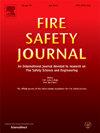The influence of small mass loss rate peaks on the rate of spread of predictive flame spread simulations: A theoretical study
IF 3.4
3区 工程技术
Q2 ENGINEERING, CIVIL
引用次数: 0
Abstract
Peaks in the mass loss rate (MLR) curve derived from thermogravimetric analysis (TGA) are commonly used to infer the pyrolysis rates of solid fuels. While the main peaks are often modelled, smaller MLR fluctuations are typically neglected, leading to discrepancies between models and experiments. The impact of these small fluctuations on key simulation predictions, however, remains unclear. This study systematically explores a specific scenario in which a small MLR fluctuation significantly affects the predicted rate of spread (ROS) of a simplified flame spread simulation. The MaCFP-recommended pyrolysis model for poly(methyl methacrylate) (PMMA) is adapted to incorporate a small MLR peak accounting for 0.5 % to 2 % of the sample’s total mass. Results from sensitivity analyses show that the peak position has the greatest impact on the ROS, followed by the peak mass fraction, while the peak width has negligible effect. Adding a small peak at lower temperatures increased the ROS by up to 6 % to 13 %, depending on the peak’s mass fraction, whereas peaks at higher temperatures had little to no effect. These results indicate that fluctuations at lower temperatures, w.r.t. the main peak, could significantly enhance the predicted spread rates and should be considered in flame spread simulations.
小质量损失率峰对预测火焰蔓延模拟蔓延速度影响的理论研究
热重分析(TGA)得到的质量损失率(MLR)曲线的峰通常用于推断固体燃料的热解速率。虽然通常对主要峰值进行建模,但通常忽略了较小的MLR波动,导致模型与实验之间存在差异。然而,这些微小的波动对关键模拟预测的影响仍不清楚。本研究系统地探讨了一个特定的场景,其中一个小的MLR波动显著影响简化火焰蔓延模拟的预测蔓延速率(ROS)。macfp推荐的聚甲基丙烯酸甲酯(PMMA)热解模型适用于包含占样品总质量0.5%至2%的小MLR峰。灵敏度分析结果表明,峰位置对活性氧的影响最大,其次是峰质量分数,而峰宽的影响可以忽略不计。在较低温度下添加一个小峰,根据峰的质量分数,ROS增加了6%到13%,而在较高温度下添加峰几乎没有影响。这些结果表明,较低温度下的波动可以显著提高预测的蔓延速度,在火焰蔓延模拟中应该考虑到这一点。
本文章由计算机程序翻译,如有差异,请以英文原文为准。
求助全文
约1分钟内获得全文
求助全文
来源期刊

Fire Safety Journal
工程技术-材料科学:综合
CiteScore
5.70
自引率
9.70%
发文量
153
审稿时长
60 days
期刊介绍:
Fire Safety Journal is the leading publication dealing with all aspects of fire safety engineering. Its scope is purposefully wide, as it is deemed important to encourage papers from all sources within this multidisciplinary subject, thus providing a forum for its further development as a distinct engineering discipline. This is an essential step towards gaining a status equal to that enjoyed by the other engineering disciplines.
 求助内容:
求助内容: 应助结果提醒方式:
应助结果提醒方式:


